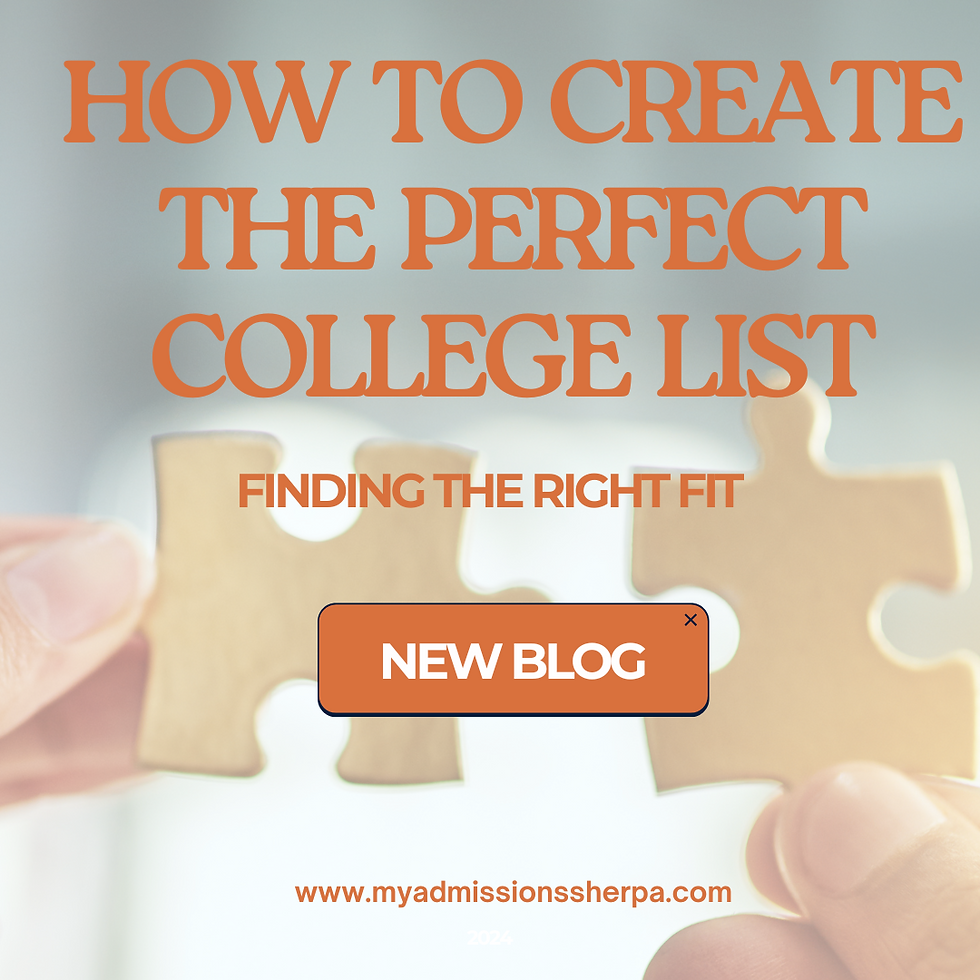How to Create the Perfect College List: Your Guide to Finding the Right Fit
Choosing the right college can feel like a daunting task, but with a little planning and reflection, you can create a college list that aligns with your personal aspirations and academic goals. Here’s a step-by-step guide to help you craft the perfect college list tailored to your unique wants and needs.
Step 1: Self-Reflection
Before diving into research, take some time to reflect on your personal preferences and academic goals. Consider the following:
Academic Interests: What subjects or fields are you passionate about?
Location Preferences: Do you prefer an urban, suburban, or rural setting? Are there specific regions or climates you’re drawn to?
Campus Size: Would you thrive in a large university environment, or do you prefer a smaller, more intimate college setting?
Extracurricular Activities: Are there sports, clubs, or organizations that are important to you?
Diversity and Culture: How important is diversity or cultural alignment in your college experience?
Step 2: Research Potential Schools
Once you have a clearer understanding of your preferences, begin researching schools that align with your criteria. Use these resources:
College Websites: Explore official college websites for detailed information on programs, campus culture, and admission requirements.
College Search Engines: Use tools like College Board’s BigFuture or Naviance to filter schools based on your interests and criteria.
Virtual Tours: Participate in virtual campus tours to get a feel for the environment without leaving home.
Step 3: Categorize Your List
To create a balanced college list, categorize your choices into three groups:
Reach Schools: Colleges that may be a bit of a stretch based on your academic profile but are worth a shot due to their prestige or unique offerings.
Match Schools: Institutions where your academic credentials fall within the average range of admitted students.
Safety Schools: Schools where your credentials exceed the average, increasing your chances of acceptance.
Reach Schools
Reach schools are those where admission might be more challenging, but the student should still consider applying due to the potential benefits if accepted.
Match Schools
Match schools are those where the student's academic profile aligns well with the average admitted student, offering a reasonable chance of acceptance.
Safety Schools
Safety schools are those where the student’s credentials are above the average for admitted students, increasing the likelihood of acceptance.
Example Student
For a student from Pennsylvania with a 3.5 GPA and 1350 SAT, having completed 3 AP courses and 5 Honors courses, here’s how you might categorize potential colleges into Reach Schools, Match Schools, and Safety Schools in state.
This categorization helps balance ambition with practicality, ensuring the student has a range of options to consider based on their academic profile and aspirations.
Category | Description | Example Schools |
Reach Schools | Highly competitive, dream schools where admission is less certain | U Penn, Carnegie Mellon, Villanova, Swarthmore College |
Match Schools | Schools that match your qualifications and where you have a strong chance of acceptance | Penn State, Drexel University, University of Pittsburgh, Gettysburg College |
Safety Schools | Schools where you’re likely to be admitted based on your strong qualifications | West Chester University, Shippensburg University, Duquesne |
Step 4: Evaluate and Shortlist
Narrow down your list by considering factors such as:
Admission Requirements: Ensure you meet or exceed the minimum requirements.
Financial Aid and Scholarships: Research the availability of financial aid and scholarships.
Campus Visits: If possible, visit campuses to get a firsthand experience of the environment.
Step 5: Finalize Your List
Aim for a balanced list of about 5-10 schools, ensuring you have a mix of reach, match, and safety schools. Remember, quality over quantity is key; focus on schools that genuinely meet your wants and needs.
Step 6: Stay Flexible
Lastly, keep an open mind. Your preferences might evolve, or you might discover new information that changes your priorities. Stay flexible and be willing to adjust your list as needed.
Creating the perfect college list is a personal journey that requires introspection, research, and thoughtful decision-making. By following this guide, you’ll be well on your way to finding a college that not only meets your academic needs but also aligns with your personal dreams and aspirations. Good luck!



.png)
.png)

This article highlights the importance of choosing the right MBA program for career growth. I completely agree that industry connections play a crucial role. When I was exploring options, I found it helpful to compare placements, faculty, and fees. Platforms like BoostMyTalent helped me research colleges like Sri Sukhmani Institute of Management PGDM course admissions, making my decision much easier.